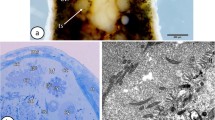Summary
The form and differentiation of the endoplasmic reticulum has been studied in the developing sperm of the crayfish, Cambaroides japonicus. Throughout development a relationship between the nuclear envelope and cytoplasmic portion of the endoplasmic reticulum has been shown to exist. Furthermore, large contributions of material from the nuclear envelope to extranuclear cytoplasmic systems has been noted in the development of early spermatids and nearly mature sperm.
A sequential predominance of several types of endoplasmic reticulum has been described in the differentiating sperm. An agranular vesicular reticulum is the most common in the early stages although annulate lamellar stacks and “rough” surfaced stacks are scattered randomly throughout the cytoplasm. Blebs of the nuclear envelope appear to contribute “rough” surfaced reticulum to the cytoplasmic system in the early spermatid. A fusion of vesicular elements results in the formation of the dense filamentous reticulum which is typical of the nearly mature sperm. Densely packed lamellae develop on the nuclear envelope in the maturing sperm and are connected to both the nuclear envelope and filamentous endoplasmic reticulum. The possible relationships of these lamellar groups to mitochondria or Golgi is discussed.
Similar content being viewed by others
Literature
Allfrey, V. G., A. E. Mirsky and H. Stern: The chemistry of the cell nucleus. Advanc. Enzymol. 16, 411–500 (1955).
Brachet, J.: Recherches sur les interactions biochimiques entre le noyau et la cytoplasme chez les organismes unicellulaires. I. Amoeba proteus. Biochim. biophys. Acta 18, 247–268 (1955).
—: Biochemical Cytology, chap. VII and VIII. New York: Academic Press 1957.
Brandt, P. W., and G. D. Pappas: Mitochondria. II. The nuclear-mitochondrial relationship in Pelomyxa carolinensis Wilson (Chaos chaos L.). J. biophys. biochem. Cytol. 6, 91–96 (1959).
Burgos, M., and D. W. Fawcett: Studies on the fine structure of the mammalian testis. I. Differentiation of the spermatids in the cat (Felis domestica). J. biophys. biochem. Cytol. 1, 287–300 (1955).
Callan, H. G., and S. G. Tomlin: Experimental studies on amphibian oocyte nuclei. I. Investigation of the structure of the nuclear membrane by means of the electron microscope. Proc. roy. Soc. B 137, 367–378 (1950).
Clermont, Y.: The Golgi zone of the rat spermatid and its role in the formation of cytoplasmic vesicles. J. biophys. biochem. Cytol. 4, Suppl., 119–122 (1956).
Fawoctt, D., and S. Ito: Observations on the cytoplasmic membranes of testicular cells, examined by phase contrast and electron microscopy. J. biophys. biochem. Cytol. 4, 135–142 (1958).
Gatenby, J. B., and A. J. Dalton: Spermiogenesis in Lumbricus herculeus. An electron microscope study. J. biophys. biochem. Cytol. 6, 45–52 (1959).
Goldstein, L., and W. Plaut: Direct evidence for nuclear synthesis of cytoplasmic ribose nucleic acid. Proc. nat. Acad. Sci. (Wash.) 41, 874–880 (1955).
Hoffman, H., and G. W. Grigg: An electron microscope study of mitochondria formation. Exp. Cell Res. 15, 118–131 (1958).
Ito, S.: The lamellar systems of cytoplasmic membranes in dividing spermatogenic cells of Drosophila virilis. J. biophys. biochem. Cytol. 7, 433–442 (1960).
Moses, M. J.: Studies on nuclei using correlated cytochemical, light, and electron microscope techniques. J. biophys. biochem. Cytol. 2, 397–406 (1956).
Palade, G. E.: Studies on the endoplasmic reticulum. II. Simple disposition in cells in situ. J. biophys. biochem. Cytol. 1, 567–582 (1955).
—: The endoplasmic reticulum. J. biophys. biochem. Cytol. 2, Suppl., 85–97 (1956).
Palay, S. L., and G. E. Palade: The fine structure of neurons. J. biophys. biochem. Cytol. 1, 69–88 (1955).
Pollister, A. W., M. Gettner and R. Ward: Nucleocytoplasmic interchange in oocytes. Science 120, 789 (Abstr.) (1954).
Porter, K. R.: The sarcoplasmic reticulum in muscle cells of Amblystoma larvae. J. biophys. biochem. Cytol. 2, Suppl., 163–173 (1956).
—: Problems in the study of nuclear fine structure. IV. Internat. Kongr. für Electronenmikrosk. 2, 186–199 (1960).
Rebhun, L. I.: Electron microscopy of basophilic structures of some invertebrate oocytes. I. Periodic lamellae and the nuclear envelope. J. biophys. biochem. Cytol. 2, 93–104 (1956).
Ruthman, A.: Basophilic lamellar systems in the crayfish spermatocyte. J. biophys. biochem. Cytol. 4, 267–273 (1958).
Watson, M. L.: Pores in the mammalian nuclear membrane. Biochim. biophys. Acta 15, 475–479 (1954).
—: The nuclear envelope. Its structure and relation to cytoplasmic membranes. J. biophys. biochem. Cytol. 1, 257–270 (1955).
—: Staining of tissues for electron microscopy with heavy metals. II. Application of solutions containing lead and barium. J. biophys. biochem. Cytol. 4, 727–730 (1958).
Yasuzumi, G., G. I. Kaye, G. D. Pappas, H. Yamamoto and I. Tsubo: Nuclear and cytoplasmic differentiation in developing sperm of Cambaroides japonicus. Z. Zellforsch. 53, 141–148 (1960).
—, H. Tanaka and O. Tezuka: Spermatogenesis in animals as revealed by electron microscopy. VIII. Relation between the nutritive cells and the developing spermatids in a pond snail, Cipangopaludina malleata, Reeve. J. biophys. biochem. Cytol. 7, 499–504 (1960a).
Author information
Authors and Affiliations
Additional information
Supported in part by Grant No B-2314 of the National Institute of Neurological Diseases and Blindness, U.S. Public Health Service.
Predoctoral Research Fellow of the National Institute of Neurological Diseases and Blindness, U.S. Public Health Service.
Rights and permissions
About this article
Cite this article
Kaye, G.I., Pappas, G.D., Yasuzumi, G. et al. The distribution and form of the endoplasmic reticulum during spermatogenesis in the crayfish, Cambaroides japonicus . Zeitschrift für Zellforschung 53, 159–171 (1961). https://doi.org/10.1007/BF00339439
Received:
Issue Date:
DOI: https://doi.org/10.1007/BF00339439




